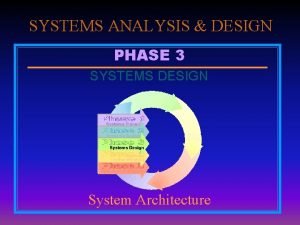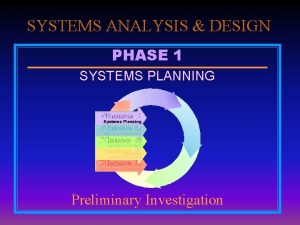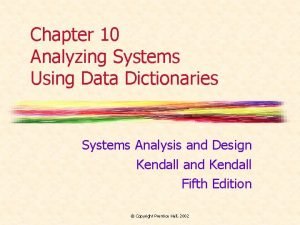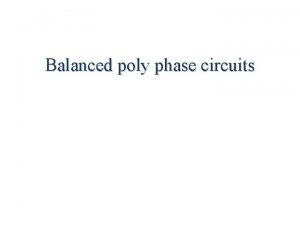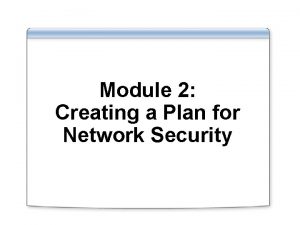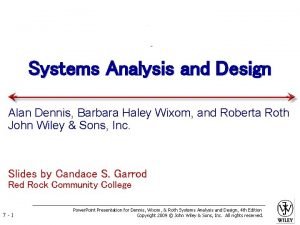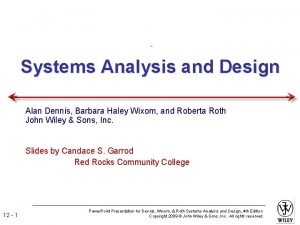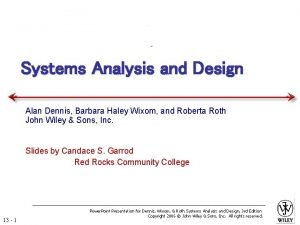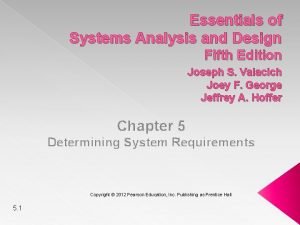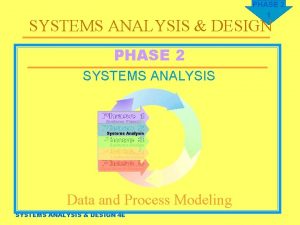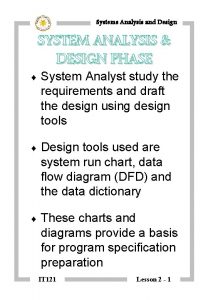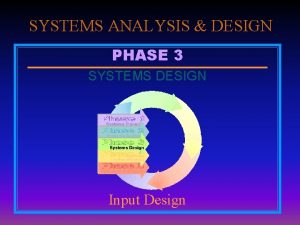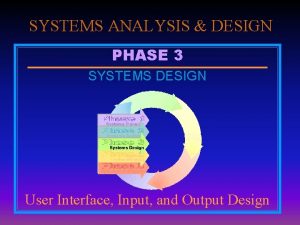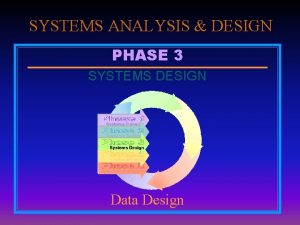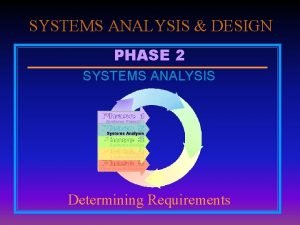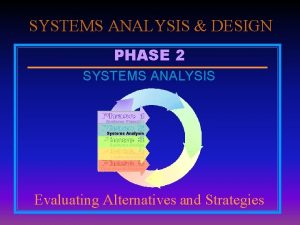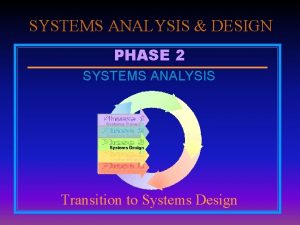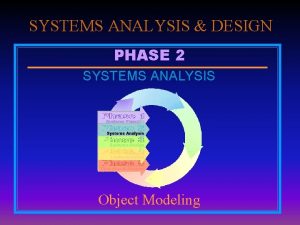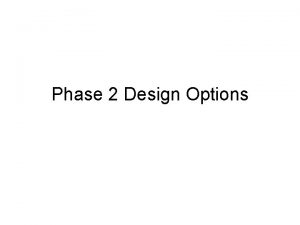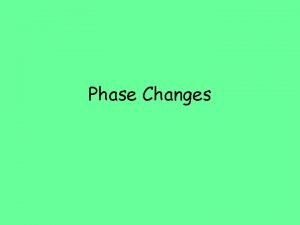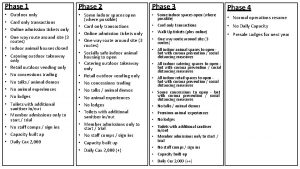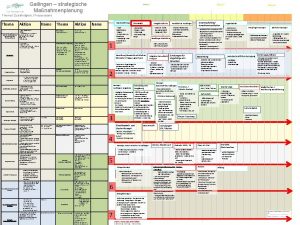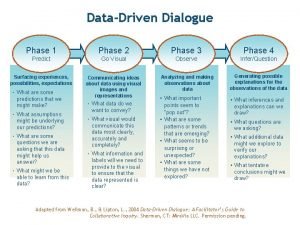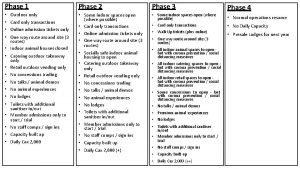SYSTEMS ANALYSIS DESIGN PHASE 2 SYSTEMS ANALYSIS Analyzing


















































- Slides: 50

SYSTEMS ANALYSIS & DESIGN PHASE 2 SYSTEMS ANALYSIS Analyzing Requirements

Chapter 4 Analyzing Requirements SYSTEMS ANALYSIS & DESIGN 3 E PHASE 2 2

Objectives PHASE 2 3 à Explain the structured analysis process and identify its elements à Describe the symbols used in data flow diagrams and explain the rules for their use à Explain the sequence of data flow diagrams, from general to specific, and what each data flow contains SYSTEMS ANALYSIS & DESIGN 3 E

Objectives PHASE 2 4 à Explain how to level and balance a set of data flow diagrams à Draw a complete set of data flow diagrams for an information system à Describe how a data dictionary is used and what it contains SYSTEMS ANALYSIS & DESIGN 3 E

Objectives PHASE 2 5 à Demonstrate the use of structured English, decision tables, and decision trees to develop information system process descriptions à Explain the relationships among data flow diagrams, the data dictionary, and process descriptions SYSTEMS ANALYSIS & DESIGN 3 E

Introduction à Systems analysis phase has three stages à Requirements determination (Chapter 3) à Requirements analysis (Chapter 4) à Evaluation of alternatives (Chapter 5) SYSTEMS ANALYSIS & DESIGN 3 E PHASE 2 6

Structured Analysis PHASE 2 7 à Examines inputs, outputs, and processes à Common method à Process-centered technique à Uses three main tools à Data flow diagrams (DFDs) à Data dictionary à Process descriptions à Tools can be applied using computer-aided software engineering (CASE) tools SYSTEMS ANALYSIS & DESIGN 3 E

PHASE 2 8 Data Flow Diagrams à Data flow diagrams (DFDs) are graphical aids that describe an information system à DFDs represent a logical model that shows what a system does, not how it does it SYSTEMS ANALYSIS & DESIGN 3 E Click to see Figure 4 -1

PHASE 2 9 Data Flow Diagrams à Data flow diagram symbols à Four basic symbols à Process à Data flow à Data store à External entity à Two popular symbol sets à Gane and Sarson à Yourdon SYSTEMS ANALYSIS & DESIGN 3 E Click to see Figure 4 -2

Data Flow Diagrams PHASE 2 10 à Process symbol à Symbol is a rectangle with rounded corners à Documented with process descriptions à Receive input data and produces output à Output has a different form, or content, or both à Details are shown in a process description à In DFDs the process symbol appears as a black box, underlying details not shown SYSTEMS ANALYSIS & DESIGN 3 E

PHASE 2 11 Data Flow Diagrams à Data flow symbol à Symbol is a line with an arrowhead showing direction à A path for data to move from one part of the system to another à Might represent one or many pieces of data à At least one data flow must enter and exit each process SYSTEMS ANALYSIS & DESIGN 3 E Click to see Figure 4 -3

PHASE 2 12 Data Flow Diagrams à Data flow symbol à Incorrect process and data flow combinations cause problems à Spontaneous generation (miracle) à Black hole à Gray hole SYSTEMS ANALYSIS & DESIGN 3 E Click to see Figure 4 -4

PHASE 2 13 Data Flow Diagrams à Data store symbol à Symbol is a rectangle open on the right side à Data store also is called a data repository à Represents data that is retained for later processing à Must be connected to a process with a data flow à Must have at least one outgoing and incoming data flow Click to see Figure 4 -5 SYSTEMS ANALYSIS & DESIGN 3 E Click to see Figure 4 -6

PHASE 2 14 Data Flow Diagrams à External entity symbol à Symbol is a square, usually shaded à Represents a person, organization, or other system that provides data or receives output from the system à External entities are called terminators à Source (supplies data to the system) à Sink (receives data from the system) Click to see Figure 4 -7 SYSTEMS ANALYSIS & DESIGN 3 E Click to see Figure 4 -8

PHASE 2 15 Data Flow Diagrams à External entity symbol à Symbol is a square, usually shaded à Represents a person, organization, or other system that provides data or receives output from the system à External entities are called terminators à Source (supplies data to the system) à Sink (receives data from the system à Must follow specific rules for connecting DFD symbols SYSTEMS ANALYSIS & DESIGN 3 E Click to see Figure 4 -9

PHASE 2 16 Data Flow Diagrams à Context diagrams à Top-level view that shows the overall boundaries of the system à Represent the results of fact-finding à One process symbol, numbered 0 (zero) is drawn in the center à Data flows connect the process to the entities à Abbreviated symbols can be used to identify entities Click to see Figure 4 -10 SYSTEMS ANALYSIS & DESIGN 3 E Click to see Figure 4 -11

PHASE 2 17 Data Flow Diagrams à Conventions for data flow diagrams à Each context diagram must fit on one page à Process name in the context diagram should be the name of the information system à Use unique names within each set of symbols à Do not cross lines à Use abbreviated identifications à Use a unique reference number for each process symbol SYSTEMS ANALYSIS & DESIGN 3 E Click to see Figure 4 -12

Data Flow Diagrams PHASE 2 18 à Diagram 0 à Displays more detail than the context diagram à Shows entities, major processes, data flows, and data stores SYSTEMS ANALYSIS & DESIGN 3 E Click to see Figure 4 -13

Data Flow Diagrams PHASE 2 19 à Shows entities, major processes, data flows, and data stores à Other characteristics à Can contain diverging data flows à Exploded (partitioned or decomposed) version of process 0 à Diagram 0 is the child of the parent context diagram à Also can be called an overview or level 0 diagram à Can contain functional primitives Click to see Figure 4 -14 SYSTEMS ANALYSIS & DESIGN 3 E Click to see Figure 4 -15

PHASE 2 20 Data Flow Diagrams à Lower-level diagrams à Usually necessary to show more detail SYSTEMS ANALYSIS & DESIGN 3 E Click to see Figure 4 -16

PHASE 2 21 Data Flow Diagrams à Lower-level diagrams à Usually necessary to show more detail à Design must consider à Leveling à Balancing à Data stores SYSTEMS ANALYSIS & DESIGN 3 E Click to see Figure 4 -17

Data Flow Diagrams PHASE 2 22 à Leveling à Process of drawing increasingly detailed diagrams à Also called exploding, partitioning, or decomposing SYSTEMS ANALYSIS & DESIGN 3 E Click to see Figure 4 -18

Data Flow Diagrams PHASE 2 23 à Balancing à Maintains consistency among an entire set of DFDs à Parent’s input and output data flows are preserved on the child SYSTEMS ANALYSIS & DESIGN 3 E Click to see Figure 4 -19

Data Flow Diagrams PHASE 2 24 à Data stores à Might not appear on higher-level DFDs à Are shown on the highest-level DFD that has two or more processes using that data store SYSTEMS ANALYSIS & DESIGN 3 E Click to see Figure 4 -20

PHASE 2 25 TRADEOFF à Which technique is better: top-down or bottom-up? à Most analysts start at the top à Draw the context diagram à Diagram 0 and lower-level diagrams next à Others start at the bottom à Identify functional primitives, data stores, external entities, and data flows à Work up until diagram 0 is reached à Results must be clear and easily understood Click to see Figure 4 -21 SYSTEMS ANALYSIS & DESIGN 3 E Click to see Figure 4 -23

A KEY QUESTION PHASE 2 26 à Based on the rules in the text, how many problems do you see in Figure 4 -22? SYSTEMS ANALYSIS & DESIGN 3 E Click to see Figure 4 -22

PHASE 2 27 Data Dictionary à Also called data repository à Documents specific facts about the system à Data flows à Data stores à External entities à Processes à Data elements (data items, fields) à Records (data structures) SYSTEMS ANALYSIS & DESIGN 3 E Click to see Figure 4 -24

Data Dictionary PHASE 2 28 à Using CASE tools to document the system à Can help create and maintain a data dictionary à Various tools are available à Visible Analyst is a popular example à Key objective is to provide clear, comprehensive information about the system SYSTEMS ANALYSIS & DESIGN 3 E

PHASE 2 29 Data Dictionary à Documenting the data elements à Must document every data element SYSTEMS ANALYSIS & DESIGN 3 E Click to see Figure 4 -25

PHASE 2 30 Data Dictionary à Documenting the data elements à Must document every data element à Standard form or CASE tool can be used à All major characteristics must be recorded and described Click to see Figure 4 -26 a SYSTEMS ANALYSIS & DESIGN 3 E Click to see Figure 4 -26 b

PHASE 2 31 Data Dictionary à Documenting the data flows à Must document every data flow à Standard form or CASE tool can be used à All major characteristics must be recorded and described SYSTEMS ANALYSIS & DESIGN 3 E Click to see Figure 4 -27

PHASE 2 32 Data Dictionary à Documenting the data stores à Must document every data store à Standard form or CASE tool can be used à All major characteristics must be recorded and described SYSTEMS ANALYSIS & DESIGN 3 E Click to see Figure 4 -28

PHASE 2 33 Data Dictionary à Documenting the processes à Must document every process à Standard form or CASE tool can be used à All major characteristics must be recorded and described SYSTEMS ANALYSIS & DESIGN 3 E Click to see Figure 4 -29

PHASE 2 34 Data Dictionary à Documenting the external entities à Must document every external entity à Standard form or CASE tool can be used à All major characteristics must be recorded and described SYSTEMS ANALYSIS & DESIGN 3 E Click to see Figure 4 -30

Data Dictionary PHASE 2 35 à Documenting the records à Must document every record à Standard form or CASE tool can be used à All major characteristics must be recorded and described SYSTEMS ANALYSIS & DESIGN 3 E Click to see Figure 4 -31

Data Dictionary PHASE 2 36 à Data dictionary reports à Data dictionary is a central storehouse for documentation à Using this data, you can produce many valuable reports SYSTEMS ANALYSIS & DESIGN 3 E

Process Description Tools PHASE 2 37 à Process description documents a functional primitive, using modular design à Modular design uses three logical structures à Sequence à Selection à Iteration SYSTEMS ANALYSIS & DESIGN 3 E

Process Description Tools PHASE 2 38 à Structured English à Subset of standard English SYSTEMS ANALYSIS & DESIGN 3 E Click to see Figure 4 -32

Process Description Tools PHASE 2 39 à Structured English à Subset of standard English à Describes process logic à Use only standard sequence, selection, and iteration structures à Use indentation for readability à Use a limited vocabulary SYSTEMS ANALYSIS & DESIGN 3 E Click to see Figure 4 -33

PHASE 2 40 Process Description Tools à Decision tables à Show a logical structure that describes process logic à Every logical combination is shown initially à Results then can be combined and simplified à Programmers can use decision tables in developing code Click to see Figure 4 -34 Click to see Figure 4 -35 SYSTEMS ANALYSIS & DESIGN 3 E Click to see Figure 4 -36

PHASE 2 41 Process Description Tools à Decision trees à Graphical representation that shows a decision table’s conditions, actions, and rules à Logic structure is shown horizontally à Easy to construct and understand à Decision table is better in complex situations Click to see Figure 4 -37 SYSTEMS ANALYSIS & DESIGN 3 E Click to see Figure 4 -38

TRADEOFF PHASE 2 42 à Logical vs. physical models à Relationship between physical and logical models: first study facts, then logical analysis à Four-model approach offers many advantages à Physical model of current system à Logical model of new system à Physical model of new system à Four-model approach can be time-consuming and expensive SYSTEMS ANALYSIS & DESIGN 3 E

A KEY QUESTION PHASE 2 43 à Is it proper to consider physical implementation questions during the systems analysis phase? à Is Rick going off on a tangent? à What are the issues? SYSTEMS ANALYSIS & DESIGN 3 E

SOFTWEAR, LIMITED PHASE 2 44 à The SWL team completed the fact-finding process à Rick and Carla are ready to prepare a logical model of the system SYSTEMS ANALYSIS & DESIGN 3 E

PHASE 2 45 SOFTWEAR, LIMITED à Data flow diagrams à Rick and Carla prepared a draft context diagram Click to see Figure 4 -39 SYSTEMS ANALYSIS & DESIGN 3 E Click to see Figure 4 -40

SOFTWEAR, LIMITED PHASE 2 46 à Data flow diagrams à Rick and Carla prepared a draft context diagram à Various revisions resulted in final version SYSTEMS ANALYSIS & DESIGN 3 E Click to see Figure 4 -41

SOFTWEAR, LIMITED PHASE 2 47 à Data flow diagrams à Rick and Carla prepared a draft context diagram à Various revisions resulted in final version à Next steps à Analysts prepared diagram 0 SYSTEMS ANALYSIS & DESIGN 3 E Click to see Figure 4 -42

SOFTWEAR, LIMITED PHASE 2 48 à Data flow diagrams à Rick and Carla prepared a draft context diagram à Various revisions resulted in final version à Next steps à Analysts prepared diagram 0 à Rick partitioned the ESIP subsystem à Carla developed other lower-level diagrams à Logical model was completed à Physical design issues were considered SYSTEMS ANALYSIS & DESIGN 3 E Click to see Figure 4 -43

PHASE 2 49 SOFTWEAR, LIMITED à Data dictionary and process descriptions à Rick and Carla’s activities à Documented the ESIP subsystem à Met with Amy Calico to review the final model Click to see Figure 4 -44 Click to see Figure 4 -46 Click to see Figure 4 -45 Click to see Figure 4 -47 Click to see Figure 4 -48 SYSTEMS ANALYSIS & DESIGN 3 E

SOFTWEAR, LIMITED PHASE 2 50 à Next steps à Meet with SWL users to review the model à Obtain input, make adjustments, get approval à Complete the payroll system model à Continue work on system requirements document SYSTEMS ANALYSIS & DESIGN 3 E
 Design systems
Design systems This is the final task in phase 3: systems design
This is the final task in phase 3: systems design This is the final task in phase 3: systems design.
This is the final task in phase 3: systems design. This is the final task in phase 3 systems design
This is the final task in phase 3 systems design Normal phase vs reverse phase chromatography
Normal phase vs reverse phase chromatography Tswett pronunciation
Tswett pronunciation Mobile phase and stationary phase
Mobile phase and stationary phase Mobile phase and stationary phase
Mobile phase and stationary phase Normal phase vs reverse phase chromatography
Normal phase vs reverse phase chromatography Power formula three phase
Power formula three phase Hplc detector types
Hplc detector types Phase to phase voltage
Phase to phase voltage Broad phase vs narrow phase
Broad phase vs narrow phase Data dictionary system analysis and design
Data dictionary system analysis and design Solved: xco 100 pts question 8 a wye-wye four-wire system
Solved: xco 100 pts question 8 a wye-wye four-wire system Design specification of an assembler
Design specification of an assembler The distribution objective must be congruent with:
The distribution objective must be congruent with: Planning phase for network security design
Planning phase for network security design Systems analysis & design in an age of options pdf
Systems analysis & design in an age of options pdf Gantt chart system analysis and design
Gantt chart system analysis and design Systems analysis and design in a changing world
Systems analysis and design in a changing world Systems analysis and design in a changing world
Systems analysis and design in a changing world Systems analysis and design dennis
Systems analysis and design dennis Introduction of system analysis and design
Introduction of system analysis and design Ssadm model
Ssadm model Modern system analysis and design
Modern system analysis and design Modern systems analysis and design
Modern systems analysis and design Kendall & kendall systems analysis and design
Kendall & kendall systems analysis and design System analysis and design dennis
System analysis and design dennis Systems analysis and design alan dennis
Systems analysis and design alan dennis Systems analysis and design alan dennis
Systems analysis and design alan dennis Systems analysis and design alan dennis
Systems analysis and design alan dennis Systems analysis and design alan dennis
Systems analysis and design alan dennis Systems analysis and design alan dennis
Systems analysis and design alan dennis Systems analysis and design alan dennis
Systems analysis and design alan dennis Ssadm diagram
Ssadm diagram Radar range equation snr
Radar range equation snr Object-oriented systems analysis and design using uml
Object-oriented systems analysis and design using uml A modern approach to systems analysis and design
A modern approach to systems analysis and design Patched-up prototype
Patched-up prototype Kendall system analysis and design
Kendall system analysis and design System analysis and design in a changing world
System analysis and design in a changing world Systems analysis and design in a changing world
Systems analysis and design in a changing world Systems analysis and design in a changing world
Systems analysis and design in a changing world Systems analysis and design alan dennis
Systems analysis and design alan dennis Systems analysis and design alan dennis
Systems analysis and design alan dennis Systems analysis and design alan dennis
Systems analysis and design alan dennis Modern systems analysis and design 7th edition
Modern systems analysis and design 7th edition Ssadm model
Ssadm model Essentials of systems analysis and design
Essentials of systems analysis and design Systems analysis and design in a changing world
Systems analysis and design in a changing world
